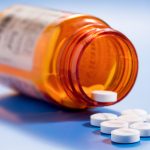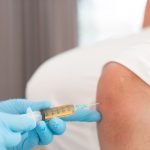Platelet-Rich Plasma Injections: A Review of Their Use in Lateral Epicondylitis
Colin MacLeod, ND
Lateral epicondylitis (LE), also known as tennis elbow, is a relatively common condition in North America, estimated to affect 1-2% of the population per year.1 The annual incidence in tennis players (amateur or professional) is much higher, at 9-35% per year.2 Notably, LE also has a 5 to 9-times higher incidence than medial epicondylitis.3 The majority (80%) of cases of LE do not require treatment and resolve on their own, while surgical treatment is resorted to in 4-11% of cases.4
Pathogenesis of Lateral Epicondylitis
LE results from overuse of the extensor muscles of the forearm, leading to damage and degeneration of the affected tendons. Tendon repair is typically slow due to a relatively low blood supply.5 Recent histopathogical studies of LE have found surprisingly low levels of inflammatory cells at the site of the affected tendon, suggesting that the term “epicondylitis” may be a misnomer. Recent research has led to the hypothesis that the pathogenesis of LE involves “hypertrophy of fibroblasts, abundant disorganized collagen, hyperplasia of vascular elements, and eventually apoptosis and extracellular matrix breakdown.”6 This degenerative mechanism has largely supplanted the older suspected inflammatory mechanism of LE. The dominant symptom of LE is pain in the region of the common extensor tendon insertion on the humerus (lateral elbow), which is worsened on performing activities involving forearm extension.
The Role of Platelets in Healing
Platelets are an integral component of the healing process, acting as a reservoir for growth factors involved in the repair process. Following injury, the endogenous inflammatory response leads to platelets being activated and delivering an array of growth factors to the site of injury, including platelet-derived growth factor (PDGF), transforming growth factor-beta (TGF-β), insulin-like growth factor (IGF), epidermal growth factor (EGF), and vascular endothelial growth factor (VEGF).7 The respective effects of each of these growth factors on injured tissue can be seen in Table 1.
Table 1. Role of Specific Growth Factors in Tissue Repair
| Growth Factor | Effect on Tissue Repair |
| PDGF | Encourages proliferation of fibroblasts, enhances collagen synthesis |
| TFG-β | Stimulates fibroblast proliferation, formation of collagen, and extracellular matrix components |
| IGF | Mediates growth and repair of skeletal muscle |
| EGF | Stimulates cellular proliferation |
| VEGF | Promotes angiogenesis |
(Adapted from Middleton, 20128)
Platelet-Rich Plasma Therapy
Mechanism of Action
Data available on platelet-rich plasma (PRP) point to it having a “2- to 8-fold increase in platelet concentration and 1- to 25-fold growth factor concentrations” of that of blood.9 It has been suggested that PRP causes an exponential increase in growth factors at the site of injection, including PDGF, TGF-β, IGF, EGF, and VEGF, and that this enrichment of growth factors stimulates healing.8 In-vitro studies have corroborated PRP treatment leading to an increase in growth-factor concentration, as well as an increase in angiogenesis, enhanced cell proliferation, and increased total collagen production of tenocyte cells.10,11 The proposed proliferative and angiogenic effect of PRP makes mechanistic sense as a treatment for the typical poor vascularity and extracellular matrix breakdown involved in common extensor tendon injury.6
PRP Preparation
Platelet-rich plasma is isolated by drawing and centrifuging a person’s own blood (autologous blood) with an anticoagulant agent. Blood is collected from the patient’s vein on the day of the procedure and is centrifuged (Figures 1,2). The centrifuged blood separates into 3 layers: platelet-poor plasma (50%), platelet-rich plasma (5%), and red blood cells (45%) (Figure 3). The PRP layer (rich in platelets) is collected and used for injecting into injured or otherwise-affected areas of the body. Standards have not been established for an optimum preparation method of PRP; as a result, clinical trials have varied in preparation methods. Centrifuging speed, centrifuging time, usage of specialized collection kits, and usage of platelet activation factors (typically calcium chloride) have varied among the available clinical trials.12 It has been suggested that anticoagulant use is necessary when preparing PRP, to avoid activation of platelets within the centrifuge and premature release of growth factors.13
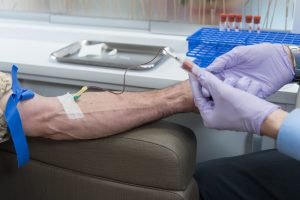
Figure 1. Blood Collection
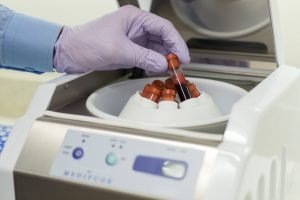
Figure 2. Centrifugation
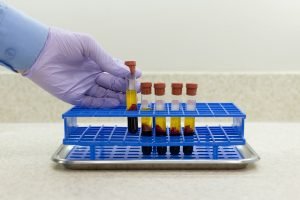
Figure 3. Layers of Blood
PRP Efficacy: Clinical Trials
The first clinical trial investigating the effect of PRP in the treatment of LE was published only 10 years ago in 2006.14 However, over the past 10 years, there has been a large number of clinical trials published on PRP’s treatment of LE. The clinical trials are fairly heterogeneous, with differences in the preparation and administration of PRP, as well as trial design.
Preparation & Administration
PRP has been prepared and administered differently by different investigators. Most investigators have used specialized kits for separating PRP from whole blood along with an anticoagulant and centrifugation,15-22 while some have simply centrifuged whole blood with an anticoagulant and manually collected PRP after centrifugation.16,23-27 There is currently no evidence that preparing PRP with a particular kit yields superior PRP compared to any other kit, or by centrifuging and extracting manually.12
Two trials have used calcium chloride for platelet activation, with the goal of stimulating growth-factor release,20,23 while most have not. It has been hypothesized that external platelet activation is not necessary for effective PRP treatment, as platelets are activated endogenously once injected.13 Also, while differing methods may be used to prepare PRP, it has been suggested that attaining a platelet concentration 4 to 6-times that of whole blood is the most important factor for achieving favorable treatment results.16 All but 1 of the available clinical trials gave only 1 injection of PRP in total, while a single trial gave 3 injections of PRP over the course of 3 weeks.18
PRP vs Corticosteroid Injections
Most of the clinical trials investigating the treatment of LE have demonstrated a significant benefit of PRP over corticosteroid injections for pain-related endpoints.21,22,24,26,28-30 A single clinical trial found that PRP injections had no beneficial effect on pain compared to corticosteroid injections15; however, there have been formal criticisms of this trial’s methodology.31,32
PRP vs Autologous Whole Blood
PRP injections are hypothesized to act similarly to autologous whole-blood injections by “increas[ing] vascularity and new collagen formation” and contributing to the healing process.20 It has been suggested that PRP could be a more efficacious treatment than autologous whole blood because of its increased concentration of growth factors.33 Autologous whole blood has been compared to PRP in a handful of clinical trials for the treatment of LE. It is not clear if PRP is more effective than autologous whole blood for treating pain associated with LE, as 1 trial comparing the 2 treatments suggested superiority of PRP,16 while 2 trials showed similar improvements with both treatments.19,34
PRP vs Other Treatments
PRP injections have also been compared to several other treatments in clinical trials. Available data suggest that PRP may be more effective than “sham” needling,17 laser therapy,18,25 and local anesthetic injections14,23 for treating pain associated with LE. One trial found that PRP was no better than saline injection.27 However, the prepared PRP in this study was estimated to have only 1.6-times the concentration of platelets compared to patients’ whole blood, which is below the 4 to 6-times concentration suspected to provide optimal results.
PRP Efficacy: Review Studies
Recent review studies (2014-2016) have either found PRP injections to be an effective treatment for LE28,35-39 or an encouraging treatment which requires further research.6,40,41 One review paper published in 2014 concluded that there is “strong evidence” that PRP is an ineffective treatment for LE.42 However, this paper has been formally criticized for containing errors, misinterpreting data, and misapplying a data-grading tool. These criticisms were made by authors of 1 of the trials that were examined in the review.43 These recent studies are listed in Table 2. Several clinical trials studying PRP’s effect on LE have also been released since this review was published.
Table 2. Recent Reviews on the Use of PRP in Lateral Epicondylitis
| Reference | Clinical Outcome |
| Yadav R, Kothari SY, Borah D28 | Effective |
| Rodik T, McDermott B35 | Effective |
| Murray DJ, Javed S, Jain N, et al36 | Effective |
| Dong W, Goost H, Lin XB, et al37 | Effective |
| Arirachakaran A, Sukthuayat A, Sisayanarane T, et al38 | Effective |
| Rodriguez JA39 | Effective |
| Kahlenberg CA, Knesek M, Terry MA6 | Encouraging, more research required |
| Thompson C, Visco C40 | Encouraging, more research required |
| Kaux JF, Drion P, Croisier JL, Crielaard JM41 | Encouraging, more research required |
| de Vos RJ, Windt J, Weir A42 | Ineffective* |
Only recent reviews (2014-2016) are included here, due to the large number of recently-published clinical trials.
*Review study performed by de Vos, Windt and Weir has been criticised for having poor methodology.43
Safety of Platelet-Rich Plasma
Because PRP is prepared from a patient’s own blood, there are no concerns about transmissible diseases as long as proper sterile technique is followed. Adverse effects of PRP injections have been rare but may include a short-term increase in inflammation and pain at the site of injection.6 Conversely, corticosteroid injections, which are a current standard of care for LE, tend to have a long-term degenerative effect on tendon integrity,44,45 encouraging “permanent adverse structural changes in the tendon.”46 The limited evidence that sonographically compares PRP injections to corticosteroid injections for LE has found that PRP encourages tissue healing while corticosteroid injections provided “short-term relief but resulted in tendon degeneration.”24 Current evidence suggests that PRP treatment has a favorable long-term safety profile compared with corticosteroid injections.
PRP injections are not recommended for pregnant women, those on anticoagulants, or those with active cancer, infection, or a bleeding disorder.
Conclusion
PRP’s use in orthopedics is a new field of study, with the first clinical trial in this area being published in 2006, only 10 years ago. However, over the past 10 years, a multitude of clinical trials and review papers have been published on the topic. LE is a condition which has met almost unanimously positive research on its treatment with PRP. The available research is clear in support of using PRP in the treatment of LE, even suggesting a significant benefit over corticosteroid injections, a commonly used treatment for LE. PRP has also thus far demonstrated minimal adverse effects compared to corticosteroid injections, which have shown evidence of progressed tendon degeneration over time.
 Colin MacLeod, ND, graduated from the Canadian College of Naturopathic Medicine in 2011, and returned to Nova Scotia to practice. Colin’s clinical focus is the treatment of pain with platelet-rich plasma, ozone therapy, neural prolotherapy, and acupuncture. He works with patients suffering from osteoarthritis, frozen shoulder, plantar fasciitis, Achilles tendonitis, and lateral epicondylitis. Colin aims to keep his patients pain-free so that they can stay physically active, social, and healthy.
Colin MacLeod, ND, graduated from the Canadian College of Naturopathic Medicine in 2011, and returned to Nova Scotia to practice. Colin’s clinical focus is the treatment of pain with platelet-rich plasma, ozone therapy, neural prolotherapy, and acupuncture. He works with patients suffering from osteoarthritis, frozen shoulder, plantar fasciitis, Achilles tendonitis, and lateral epicondylitis. Colin aims to keep his patients pain-free so that they can stay physically active, social, and healthy.
References
- Verhaar JA. Tennis elbow. Anatomical, epidemiological and therapeutic aspects. Int Orthop. 1994;18(5):263-267.
- Pluim BM, Staal JB, Windler GE, Jayanthi N. Tennis injuries: occurrence, aetiology, and prevention. Br J Sports Med. 2006;40(5):415-423.
- Gabel GT. Acute and chronic tendinopathies at the elbow. Curr Opin Rheumatol. 1999;11(2):138-143.
- Calfee RP, Patel A, DaSilva MF, Akelman E. Management of lateral epicondylitis: current concepts. J Am Acad Orthop Surg. 2008;16(1):19-29.
- Liu CF, Aschbacher-Smith L, Barthelery NJ, et al. What we should know before using tissue engineering techniques to repair injured tendons: a developmental biology perspective. Tissue Eng Part B Rev. 2011;17(3):165-176.
- Kahlenberg CA, Knesek M, Terry MA. New Developments in the Use of Biologics and Other Modalities in the Management of Lateral Epicondylitis. Biomed Res Int. 2015;2015:439309.
- Lubkowska A, Dolegowska B, Banfi G. Growth factor content in PRP and their applicability in medicine. J Biol Regul Homeost Agents. 2012;26(2 Suppl 1):3S-22S.
- Middleton KK, Barro V, Muller B, et al. Evaluation of the effects of platelet-rich plasma (PRP) therapy involved in the healing of sports-related soft tissue injuries. Iowa Orthop J. 2012;32:150-163.
- Hall MP, Band PA, Meislin RJ, et al. Platelet-rich plasma: current concepts and application in sports medicine. J Am Acad Orthop Surg. 2009;17(10):602-608.
- de Mos M, van der Windt AE, Jahr H, et al. Can platelet-rich plasma enhance tendon repair? A cell culture study. Am J Sports Med. 2008;36(6):1171-1178.
- Anitua E, Andía I, Sanchez M, et al. Autologous preparations rich in growth factors promote proliferation and induce VEGF and HGF production by human tendon cells in culture. J Orthop Res. 2005;23(2):281-286.
- Dhurat R, Sukesh M. Principles and Methods of Preparation of Platelet-Rich Plasma: A Review and Author’s Perspective. J Cutan Aesthet Surg. 2014;7(4):189-197.
- Marx RE. Platelet-rich plasma: evidence to support its use. J Oral Maxillofac Surg. 2004;62(4):489-496.
- Mishra A, Pavelko T. Treatment of chronic elbow tendinosis with buffered platelet-rich plasma. Am J Sports Med. 2006;34(11):1774-1778.
- Krogh TP, Fredberg U, Stengaard-Pedersen K, et al. Treatment of lateral epicondylitis with platelet-rich plasma, glucocorticoid, or saline: a randomized, double-blind, placebo-controlled trial. Am J Sports Med. 2013;41(3):625-635.
- Raeissadat SA, Sedighipour L, Rayegani SM, et al. Effect of Platelet-Rich Plasma (PRP) versus Autologous Whole Blood on Pain and Function Improvement in Tennis Elbow: A Randomized Clinical Trial. Pain Res Treat. 2014;2014:191525.
- Mishra AK, Skrepnik NV, Edwards SG, et al. Efficacy of platelet-rich plasma for chronic tennis elbow: a double-blind, prospective, multicenter, randomized controlled trial of 230 patients. Am J Sports Med. 2014;42(2):463-471.
- Tetschke E, Rudolf M, Lohmann CH, Starke C. Autologous proliferative therapies in recalcitrant lateral epicondylitis. Am J Phys Med Rehabil. 2015;94(9):696-706.
- Thanasas C, Papadimitriou G, Charalambidis C, et al. Platelet-rich plasma versus autologous whole blood for the treatment of chronic lateral elbow epicondylitis: a randomized controlled clinical trial. Am J Sports Med. 2011;39(10):2130-2134.
- Creaney L, Wallace A, Curtis M, Connell D. Growth factor-based therapies provide additional benefit beyond physical therapy in resistant elbow tendinopathy: a prospective, single-blind, randomised trial of autologous blood injections versus platelet-rich plasma injections. Br J Sports Med. 2011;45(12):966-971.
- Hechtman KS, Uribe JW, Botto-vanDemden A, Kiebzak GM. Platelet-rich plasma injection reduces pain in patients with recalcitrant epicondylitis. 2011;34(2):92.
- Peerbooms JC, Sluimer J, Bruijn DJ, Gosens T. Positive effect of an autologous platelet concentrate in lateral epicondylitis in a double-blind randomized controlled trial: platelet-rich plasma versus corticosteroid injection with a 1-year follow-up. Am J Sports Med. 2010;38(2):255-262.
- Behera P, Dhillon M, Aggarwal S, et al. Leukocyte-poor platelet-rich plasma versus bupivacaine for recalcitrant lateral epicondylar tendinopathy. J Orthop Surg (Hong Kong). 2015;23(1):6-10.
- Gautam VK, Verma S, Batra S, et al. Platelet-rich plasma versus corticosteroid injection for recalcitrant lateral epicondylitis: clinical and ultrasonographic evaluation. J Orthop Surg (Hong Kong). 2015;23(1):1-5.
- Tonk G, Kumar A, Gupta A. Platelet rich plasma versus laser therapy in lateral epicondylitis of elbow. Indian J Orthop. 2014;48(4):390-393.
- Tan XX, Ju HY, Yan W, et al. Autologous platelet lysate local injections for the treatment of refractory lateral epicondylitis. J Orthop Surg Res. 2016;25;11(1):17.
- Montalvan B, Le Goux P, Klouche S, et al. Inefficacy of ultrasound-guided local injections of autologous conditioned plasma for recent epicondylitis: results of a double-blind placebo-controlled randomized clinical trial with one-year follow-up. Rheumatology (Oxford). 2016;55(2):279-285.
- Yadav R, Kothari SY, Borah D. Comparison of Local Injection of Platelet Rich Plasma and Corticosteroids in the Treatment of Lateral Epicondylitis of Humerus. J Clin Diagn Res. 2015;9(7):RC05-RC07.
- Gosens T, Peerbooms JC, van Laar W, den Oudsten BL. Ongoing positive effect of platelet-rich plasma versus corticosteroid injection in lateral epicondylitis: a double-blind randomized controlled trial with 2-year follow-up. Am J Sports Med. 2011;39(6):1200-1208.
- Khaliq A, Khan I, Inam M, et al. Effectiveness of platelets rich plasma versus corticosteroids in lateral epicondylitis. J Pak Med Assoc. 2015;65(11 Suppl 3):S100-S104.
- Wilson JJ, Rabago DP, Lee KS. Platelet-rich plasma treatment for lateral epicondylitis: letter to the editor. Am J Sports Med. 2013;41(7):NP33-NP34.
- Shiple BJ. How effective are injection treatments for lateral epicondylitis? Clin J Sport Med. 2013;23(6):502-503.
- Mishra A, Randelli P, Barr C, et al. Platelet-rich plasma and the upper extremity. Hand Clin. 2012;28(4):481-491.
- Raeissadat SA, Rayegani SM, Hassanabadi H, et al. Is Platelet-rich plasma superior to whole blood in the management of chronic tennis elbow: one year randomized clinical trial. BMC Sports Sci Med Rehabil. 2014;6:12.
- Rodik T, McDermott B. Platelet-Rich Plasma Compared With Other Common Injection Therapies in the Treatment of Chronic Lateral Epicondylitis. J Sport Rehabil. 2016;25(1):77-82.
- Murray DJ, Javed S, Jain N, et al. Platelet-Rich-Plasma Injections in Treating Lateral Epicondylosis: a Review of the Recent Evidence. J Hand Microsurg. 2015;7(2):320-325.
- Dong W, Goost H, Lin XB, et al. Injection therapies for lateral epicondylalgia: a systematic review and Bayesian network meta-analysis. Br J Sports Med. pii: bjsports-2014-094387. [Epub ahead of print]
- Arirachakaran A, Sukthuayat A, Sisayanarane T, et al. Platelet-rich plasma versus autologous blood versus steroid injection in lateral epicondylitis: systematic review and network meta-analysis. J Orthop Traumatol. 2015 Sep 11. [Epub ahead of print]
- Rodriguez JA. Corticosteroid versus platelet-rich plasma injection in epicondylitis. Orthop Nurs. 2014;33(5):257-265.
- Thompson C, Visco C. Lateral epicondylosis: emerging management options. Curr Sports Med Rep. 2015;14(3):215-220.
- Kaux JF, Drion P, Croisier JL, Crielaard JM. Tendinopathies and platelet-rich plasma (PRP): from pre-clinical experiments to therapeutic use. J Stem Cells Regen Med. 2015;30;11(1):7-17.
- de Vos RJ, Windt J, Weir A. Strong evidence against platelet-rich plasma injections for chronic lateral epicondylar tendinopathy: a systematic review. Br J Sports Med. 2014;48(12):952-956.
- Gosens T, Mishra AK. Editorial in response to the systematic review by de Vos et al: ‘Strong evidence against platelet-rich plasma injections for chronic lateral epicondylar tendinopathy: a systematic review’. Br J Sports Med. 2014;48(12):945-946.
- Smidt N, van der Windt DA, Assendelft W, et al. Corticosteroid injections, physiotherapy, or a wait-and-see policy for lateral epicondylitis: a randomised controlled trial. 2002;23;359(9307):657-662.
- Bisset L, Smidt N, Van der Windt DA, et al. Conservative treatments for tennis elbow do subgroups of patients respond differently? Rheumatology (Oxford). 2007;46(10):1601-1605.
- Jobe FW, Ciccotti MG. Lateral and Medial Epicondylitis of the Elbow. J Am Acad Orthop Surg. 1994;2(1):1-8.




